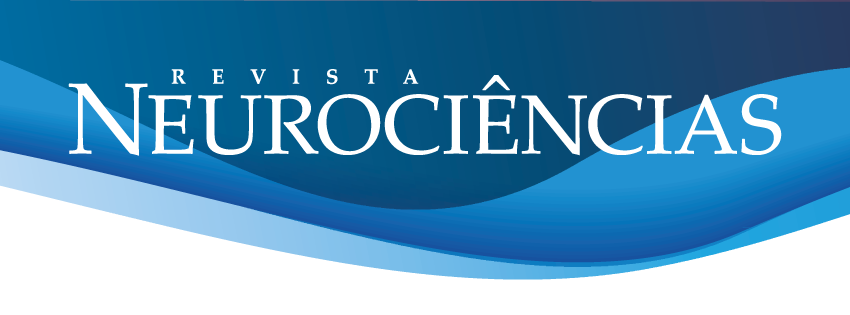Characteristics of aphasias in Malignant Ischemic Stroke
DOI:
https://doi.org/10.34024/rnc.2023.v31.15216Keywords:
Ischemic stroke, Aphasia, Decompressive Craniectomy, speech therapy, Neurology, DysphagiaAbstract
Objectives. To investigate clinical-neurological factors and aphasia in patients with malignant ischemic stroke in the left cerebral hemisphere, submitted or not to decompressive craniectomy during hospitalization. Method. Descriptive, retrospective study, based on the analysis of medical records, of a series of cases, of patients admitted to the Cerebrovascular Accident Unit (U-AVC), of Hospital Risoleta Tolentino Neves (HRTN), from January 2019 to December 2021. The inclusion criteria were patients over 18 years of age, of both sexes, who received the diagnosis of malignant ischemic stroke by Neurology, and who underwent the Speech-Language Pathology evaluation, where the description of the characteristics of the patients' aphasia was verified, focusing on the presented linguistic symptoms, followed by speech-terapy intervention in the unit. Results. Five patients were selected and classified with non-fluent aphasic conditions, but with different severities and characteristics. Three of the participants underwent decompressive craniectomy and all five participants had dysphagia. The average time to start addressing language aspects was 10 days, and the five patients showed improvement in language at hospital discharge. Conclusions. The patients presented non-fluent aphasic conditions with linguistic improvement after Speech-Language Pathology intervention, the comprehension and the presence of oral expressions, the main evolutionary characteristics observed among the participants.
Metrics
Downloads
References
Santana MT, Chun RY. Linguagem e funcionalidade de adultos pós-Acidente Vascular Encefálico (AVE): avaliação baseada na Classificação Internacional de Funcionalidade, Incapacidade e Saúde (CIF). Codas 2017;29:e20150284. https://doi.org/10.1590/2317-1782/20172015284
Arruda JS, Reis FP, Fonseca V. Avaliação da linguagem após acidente vascular cerebral em adultos no estado de Sergipe. Rev Cefac 2014;16:853-62. http://doi.org/10.1590/1982-021620142613
Couto PB, Neves VD, Barreto SD. Frequência de afasia e perfil de usuários em hospital público municipal de referência. Audiol Comm Res 2020;25:e2288. https://doi.org/10.1590/2317-6431-2020-2288
Verly YO, Barreto SD. Adesão ao tratamento fonoaudiológico por pessoas com afasia encaminhadas após alta hospitalar: estudo de dois casos. Audiol Comm Res 2020;25:e2289. https://doi.org/10.1590/2317-6431-2020-2289
Guimarães CS. Craniectomia de descompressão no AVC. Uma série de casos. Porto: Instituto de Ciências Biomédicas Abel Salazar. Universidade do Porto. 2019; 68p. https://repositorio-aberto.up.pt/bitstream/10216/121376/2/343947.pdf
Nobre MC, Monteiro M, Albuquerque AC, Veloso AT, Mendes VA, Silveira MF, et al. Craniectomia descompressiva para tratamento de hipertensão intracraniana secundária a infarto encefálico isquêmico extenso: análise de 34 casos. Arq Neuropsiquiatr 2007;65:107-13. https://doi.org/10.1590/S0004-282X2007000100022
Júnior MA, Fernandes CM, Naves ÉA, Costa GA. Craniotomia descompressiva: análise crítica baseada em relatos de caso. Arq Bras Neurocirur Braz Neurosurg 2013;32:250-4. https://doi,org/10.1055/s-0038-1626024
Sousa CDD, Jacinto ABG, Silva VC. Desfechos funcionais após craniectomia descompressiva secundária à acidente vascular encefálico. Fisioter Bras 2020;21:39. https://doi.org/10.33233/fb.v21i1.3260
Sampaio GR, Moreira E. Caracterização dos distúrbios comunicativos em indivíduos pós AVCI por meio da aplicação adaptada da bateria MAC. Dist Com 201619;28:452-61. https://revistas.pucsp.br/index.php/dic/article/view/26751/20851
Benson DF. Aphasia and the Lateralization of Language. Cortex 1986;22:71-86. https://doi.org/10.1016/S0010-9452(86)80033-8
Vieira AC, Roazzi A, Queiroga BM, Asfora R, Valença MM. Afasias e áreas cerebrais: argumentos prós e contras à perspectiva localizacionista. Psicol Refl Crít 2011;24:588-96. https://doi.org/10.1590/S0102-79722011000300020
Dronkers N, Ogar J. Brain areas involved i speech production. Brain 2004;127:1461-2. https://doi.org/10.1093/brain/awh233
Guanci MM. Management of the Patient with Malignant Hemispheric Stroke. Crit Care Nurs Clin North Am 2020;32:51-66. https://doi.org/10.1016/j.cnc.2019.11.003
Adams HP, Davis PH, Leira EC, Chang KC, Bendixen BH, Clarke WR, et al. Baseline NIH Stroke Scale score strongly predicts outcome after stroke: a report of the Trial of Org 10172 in Acute Stroke Treatment (TOAST). Neurology 1999;53:126. https://doi.org/10.1212/WNL.53.1.126
Rubiera AB, Plasencia LMM, Martínez YA. Disfagia en paciente con enfermedad cerebrovascular. Actualización. Medisur 2009;7:36-44. http://scielo.sld.cu/scielo.php?script=sci_arttext&pid=S1727-897X2009000100007&lng=es
Hongo T, Yamamoto R, Liu K, Yaguchi T, Dote H, Saito R, et al. Association between timing of speech and language therapy initiation and outcomes among post-extubation dysphagia patients: a multicenter retrospective cohort study. Critical Care 2022;26:98. https://doi.org/10.1186/s13054-022-03974-6
Andrade JS, Souza WWOJ, Paranhos LR, Domenis DR, César CPHAR. Efeitos da Terapia da Fala em Pacientes Internados com Disfagia Pós-Acidente Cerebrovascular: Revisão Sistemática de Estudos Observacionais. Acta Med Port 2017;30:870-81. https://doi.org/10.20344/amp.9183
Jacques A, Cardoso MC. Acidente Vascular Cerebral e sequelas fonoaudiológicas: atuação em área hospitalar. Rev Neurocienc 2011;19:229-36. https://doi.org/10.34024/rnc.2011.v19.8371
Rosendo BV, Gonçalves LF, Mituuti CT, Haas P. Fatores associados à disfagia em pacientes com AVC: uma revisão sistemática. Rev Neurocienc 2021;29:1-24. https://doi.org/10.34024/rnc.2021.v29.11940
Goulart BN, Almeida CP, Silva MW, Oenning NS, Lagni VB. Caracterização de acidente vascular cerebral com enfoque em distúrbios da comunicação oral em pacientes de um hospital regional. Audiol Comm Res 2016;21:e1603. http://doi.org/10.1590/2317-6431-2015-1603
Glize B, Villain M, Richert L, Vellay M, Gabory I, Mazaux JM, et al. Language features in the acute phase of poststroke severe aphasia could predict the outcome. Eur J Phys Rehabil Med 2017;53:249-55. https://doi.org/10.23736/S1973-9087.16.04255-6
Kastrau F, Wolter M, Huber W, Block F. Recovery from aphasia after hemicraniectomy for infarction of the speech-dominant hemisphere. Stroke 2005;36:825-9. https://doi.org/10.1161/01.STR.0000157595.93115.70
Wijdicks EF, Sheth KN, Carter BS, Greer DM, Kasner SE, Kimberly WT, et al. American Heart Association Stroke Council. Recommendations for the management of cerebral and cerebellar infarction with swelling: a statement for healthcare professionals from the American Heart Association/American Stroke Association. Stroke 2014;45:1222-38. https://doi.org/10.1161/01.str.0000441965.15164.d6
Downloads
Published
How to Cite
Issue
Section
License
Copyright (c) 2023 Raíssa Caroline Sales Costa , Yoná Silva Rabelo, Naiany Nascimento da Silva Figueiredo, Romeu Vale Sant ́Anna, Aline Mansueto Mourão

This work is licensed under a Creative Commons Attribution 4.0 International License.
##plugins.generic.dates.accepted## 2023-09-21
##plugins.generic.dates.published## 2023-10-25


 Português
Português
 English
English
 Español
Español
